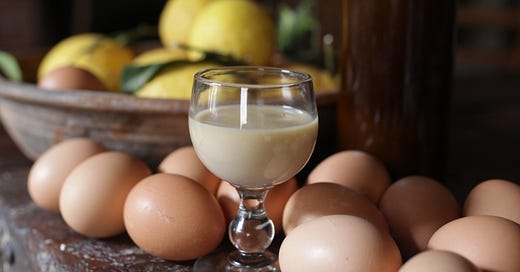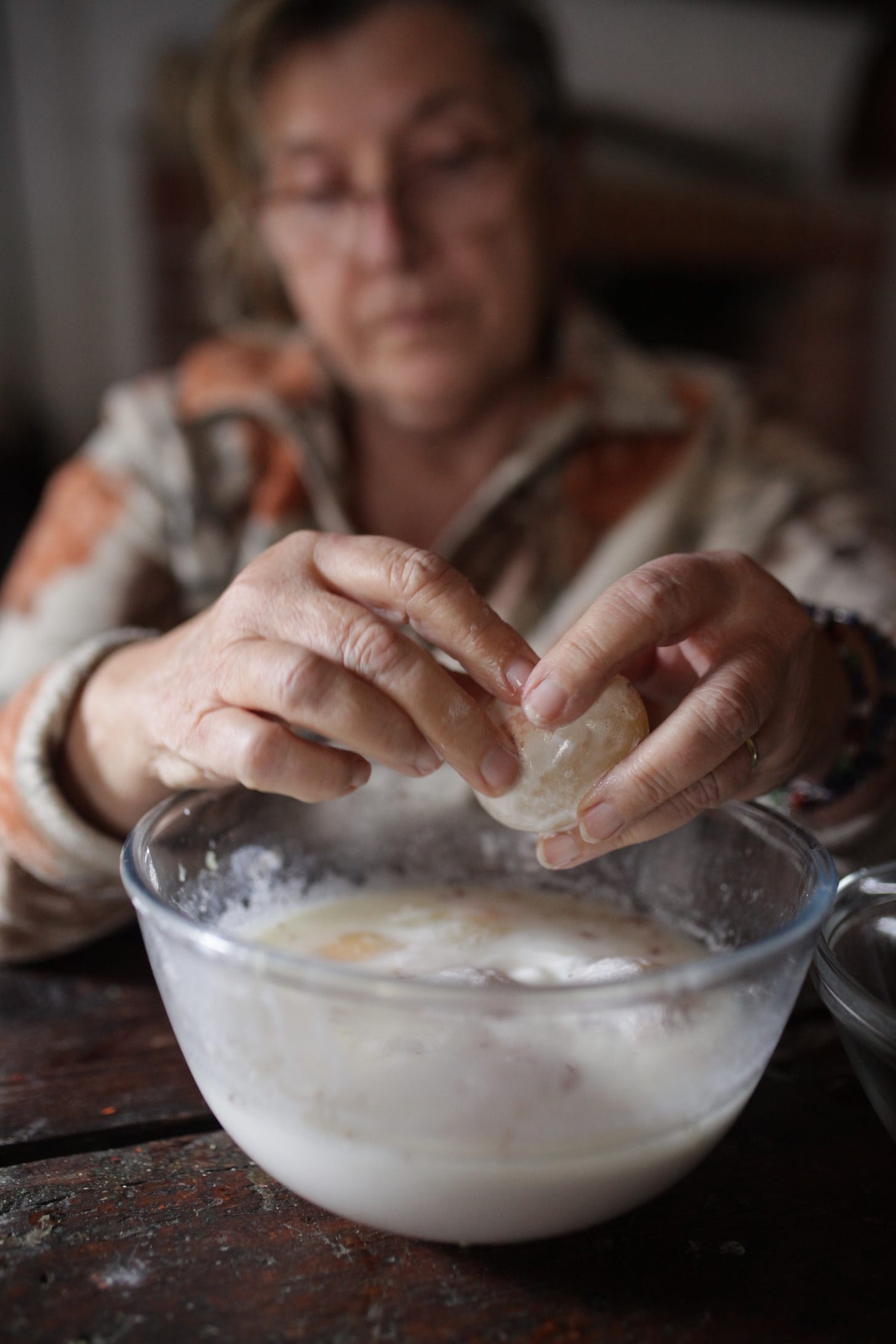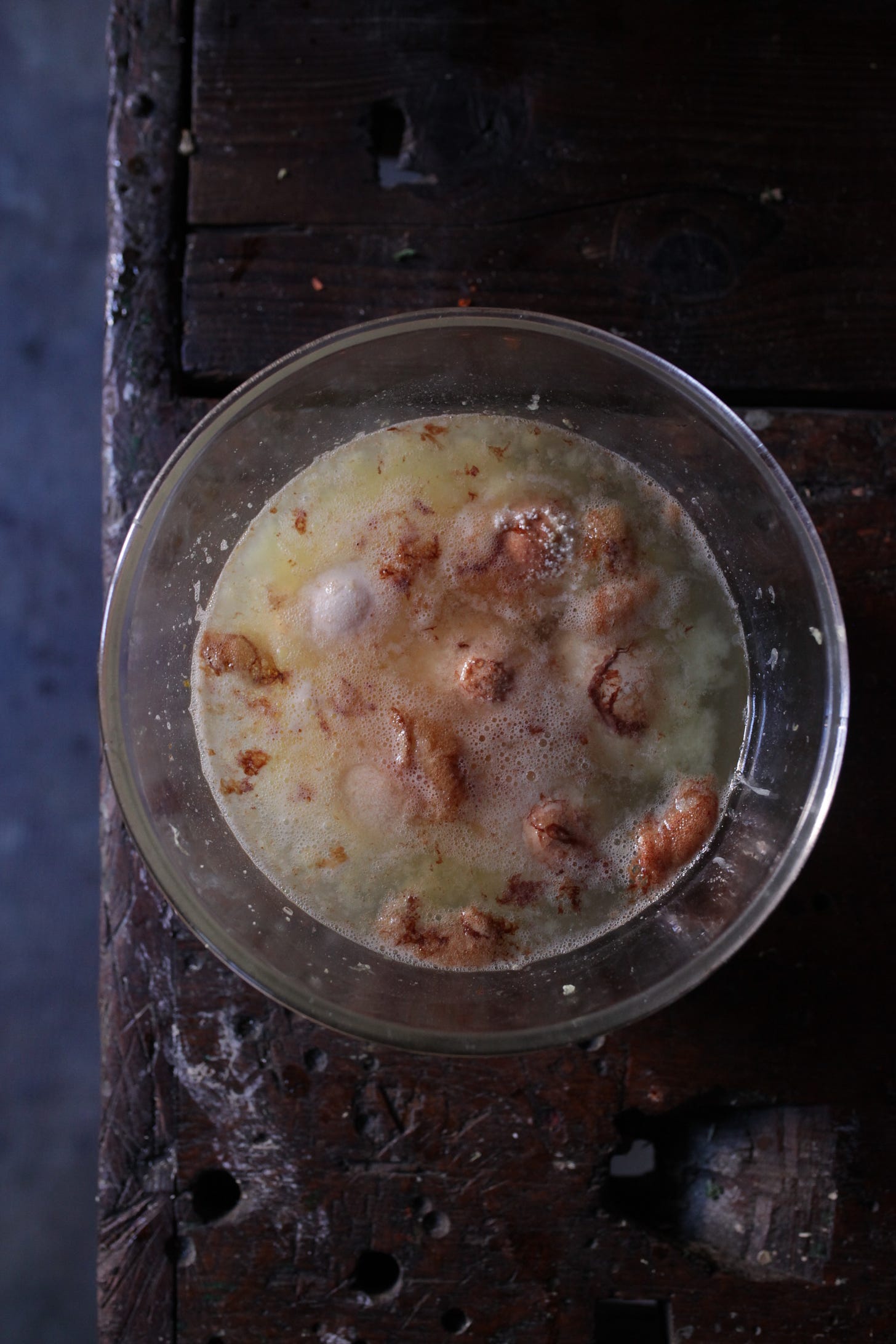LIQUORE d'UOVO // Piemonte - Veneto // ITALY
Delicious home-made egg liqueur for the pantry that is an absolute MUST as we enter the cold and wet of autumn. A forgotten pick-me-up whose roots are steeped in 5th century egg preservation.
I often forget about drink in my research of how we preserve the landscape into food, and this is an absolute belter I discovered from rooting through hand-written recipes that lead to remembering the last use of it in our family in the 1960s. This recipe isn’t a way to preserve eggs for use in the future, but rather a way of stabilising their nutritional value when they are abundant for consumption in the leaner months, with this particular method used for its beneficial medicinal properties.
Nobody really makes this humble and delicious liqueur at home anymore, as medicinally beneficial as it is delicious.
Paid subscribers get detailed method and 20+ full frame photographs of the different stages, as this takes a week to make.
LIQUORE D’UOVO
This is a busy time of year over here at Up There The Last. Next week sees us head off to the mountains for the desalpa transhumance, and traditional chestnut harvest in northern Italy, which I can’t wait to write about over the coming weeks. I’m reminded that last year I brought with me a bottle of my own liquore d’uovo, and it’s just perfect to sip on before setting out, and also when coming home from these old and strenuous autumn happenings. I only drink it now and in spring, and it reenforces the seasons.
This is one of the more successful ways I have had of preserving eggs, and I strongly recommend you try it at home.
It came about by speaking with my family and some older folk from the town of Camburzano about eggs and how might there have been a way to preserve them to roll into the winter when hens lay less frequently. I had researched the tradition of buttered eggs, the Irish technique of covering extremely fresh eggs in a thin layer of butter to block the porous shell and preventing oxidation (more on this soon, I have had very mixed and foul results), and knew that from observing life in the foothills of the alps, so much of food production is based on gearing up for winter that there must have been an eggy way too.
The conversation lead to Vov, a famous Italian commercialised egg liqueur that came about in the 1800’s as a way to use up egg yolks left from Torrone production, a type of nougat made with egg whites. But though they are spoken of as the same, Vov doesn’t actually have the same ingredients or method as the much more ancient Liquore d’Uovo- a technique that permeated the northern mountain regions and became an established part of seasonal preservation of the whole egg by housewives and countryfolk, with its shell dissolving into the liquid, that so beautifully worked its way into the yearly routine of production.
Not only this, but I have seen it in high chalets of the alpigiani and cascine (farmhouses) in the valleys, suggesting to me that we are dealing with something far older than we might think. This idea that light and time is precious, where we used absolutely everything. That winter is hard and food scarce, so in readiness for the seasonal change, much like cheese, we preserve when things are in abundance to see us through the harshness of winter. This is behind everything that the alpigiani did, and still now just about, do. These techniques are part of a long-established survivalist mentality, and inextricably binding to their given geographical context.
Asking my mum if she remembered having this drink as a child in the pre-alps of the Biellese revealed some authentic use in autumn of the Liquore d’Uovo as she remembers it as a child in the 50s. Taken for two weeks leading up to winter, it served as a pick-me-up at breakfast or in the afternoon for merenda (tea-time) after school, usually accompanied by a slice of bread, mountain butter and mostarda, sometimes, with roasted chestnuts if they were already falling.
It is amongst my mother’s earliest memories- it worked wonders as a little morale booster against the dark and cold, in a time where this was much needed. Deliciously sweet and silky with a curious texture and fullness that comes from the dissolved eggshell, it would be made from the end of summer to around now, with bottles lasting through the winter, then made again with the first eggs of spring, taken for two weeks at breakfast and merenda for its restorative effects as families emerged from winter.
If we consider the four ingredients of egg, sugar, lemon and marsala, it makes a little more sense. Alcohol, protein, sugar, vitamins, minerals. It’s no wonder that it carried through to WW2 as a ration for Italian soldiers, where it was known as VAV2, from Vino Alimentare Vigoroso - “vigorous food wine”.
But what I love is how time passes.
Listen. Time passes.
People’s lives come and go, kingdoms rise and fall, but the recipes remain as an objective leveller- an apolitical, highly personal friend that we can fall back to and trust, uplifting morale-booster that holds us to our childhood and home, well into the future. This recipe comes from my grandfather’s brother Mario, who fell in love with a Catanian girl called Graziella whilst he was a prisoner to the English in Sicily during WW2.
When he was freed, they returned to the mountains of Biella in the north, my own mother remembering Graziella’s family sending crates of beautiful Sicilian lemons on the back of lorries so they could make Liquore d’uovo. It was always there, for them to grow up with before the war, developed from even older recipes from farmhouses of the 17th century using oxidised white wine instead of Marsala, and before then made with beer and honey, given to pregnant women as a restorative in the 5th century. (There are links here with the famous dessert zabaglione, but this is another recipe for another entry into the archive.)
The fascinating technique of using acid to dissolve the shell for its calcium has roots in ancient Rome when lemons arrived in Sicily around 200 AD. What a way to consume minerals- eggshells are 94% calcium carbonate.
I can’t think of a better drink with which to boost the immune system for the coming winter, and it’s completely delicious.
Now to you. It’s so simple. This is DEFINITELY one to try, and it might well become part of your year forever.
Here’s how to do it.
Keep reading with a 7-day free trial
Subscribe to Up There The Last to keep reading this post and get 7 days of free access to the full post archives.






